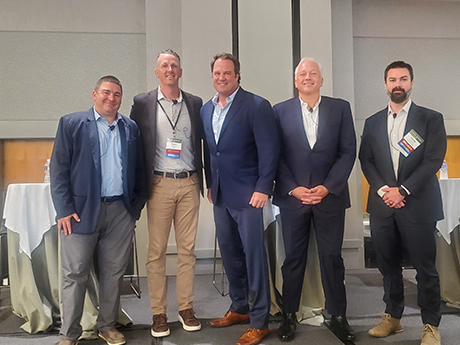As a bridge lender across the full spectrum of seniors housing, Live Oak Bank has been able to capitalize on the limited liquidity in today’s market that has resulted in stalled transactions and refinancing challenges in this niche property sector.
“Trust me, I have a certain advantage right now with the lack of lenders [active in the space], and I enjoy that because it enables me to be very strategic on relationships and the people that I choose to partner with and grow. But having liquidity back in our market is necessary for a healthy seniors sector,” believes Chad Borst, managing director of seniors housing at Live Oak Bank, headquartered in Wilmington, North Carolina.
Editor’s note: InterFace Conference Group, a division of France Media Inc., produces networking and educational conferences for commercial real estate executives. To sign up for email announcements about specific events, visit www.interfaceconferencegroup.com/subscribe.
Borst would like to see banks that moved to the sidelines in recent years due to the disruption in the capital markets return to the playing field. “I want the permanent financing market to open up more broadly. I want other banks to come back because it will help the overall health of our entire sector, which props us all up.”
He’s not optimistic that’s going to happen in the short term, however. “The broader commercial real estate issues are going to continue impacting banks into 2025, and one or two rate cuts [by the Federal Reserve] isn’t impactful. That’s not what they’re looking for,” said Borst.
“They’re not worried about where the rate is. They’re worried about where the health of their portfolio is, and it’s not just on the seniors housing side,” he added, referring to troubled office and retail portfolios. To move that product off their books, lenders would likely need to incur large write-downs.
Borst’s comments came during the capital markets panel discussion at InterFace Seniors Housing Southeast in Atlanta on Wednesday, Aug. 28. In addition to Borst, the five-member panel included Justin Elshire, director, Lument; Robert Gall, director, seniors housing and care, Ziegler; Taylor Mokris, senior vice president, seniors housing and care, BWE; and Corley Audorff, senior vice president, production, Colliers Mortgage.
Audorff served as panel moderator for the nearly hour-long capital markets discussion. Hosted by France Media’s InterFace Conference Group and Seniors Housing Business, the conference took place at Westin Buckhead Atlanta and drew 358 industry professionals.
Improving vital signs
NIC MAP data shows continual improvement every quarter since the industry hit the trough. The seniors housing occupancy rate across the 31 NIC MAP primary markets rose 0.5 percentage points to 85.9 percent in the second quarter, the 12th consecutive quarter of occupancy gains. The occupancy rate for assisted living was 84.3 percent in the second quarter, just shy of its prior peak of 84.4 percent. The occupancy rate for independent living was 87.6 percent, two percentage points from its prior peak.
“I remain bullish that not only have we made strong incremental improvement, but we’re at a point where now the demographic tailwinds can continue to push us to levels that we enjoyed prior to the overbuilding cycle of 2015 to 2019,” said Borst. “Any other tailwinds that help us, like lowering of interest rates, are going to incrementally improve the strength of our borrowers and the liquidity in the market.”
Elshire, who works out of Lument’s Nashville office, pointed out that the seniors housing industry has endured unprecedented challenges over the last five years that have included the COVID-19 pandemic, major staffing issues, inflation and a disruption in the capital markets due a sharp rise in interest rates. The industry should give itself a pat on the back for weathering the storm so skillfully, he said.
All eyes are on the Fed
The big question on everyone’s mind heading into the fall season: How aggressively will the Federal Reserve cut interest rates at its next meeting slated for Sept. 17-18. As of late August, the betting markets indicated a 70 percent probability of a quarter-point rate cut in September.
The current federal funds target rate — the interest rate at which commercial banks lend to each other overnight — is 5.25 to 5.5 percent. Movement in the federal funds rate has a direct impact on the Secured Overnight Financing Rate (SOFR), the benchmark used for variable-rate financing deals in commercial real estate. As of early September, the 30-day SOFR rate was 5.34 percent.
The Federal Reserve hiked interest rates 11 times between March 2022 and July 2023 to combat inflation. The Consumer Price Index rose at an annual rate of 2.9 percent in July, the lowest level since March 2021 and down dramatically from 9.1 percent in June 2022. The Fed’s target is 2 percent annual inflation.
BWE’s Mokris believes the seniors housing industry is poised to perform well in the near term regardless of the Fed’s actions or the health of the U.S. economy. If the Fed moves to cut rates, the industry will encounter relatively lower borrowing rates, equity will start flowing back into the sector, all the while real estate fundamentals will continue to improve, he said.
“If we slam on the brakes and there is a slight or even moderate recession, I still think that might not be a bad thing on a relative basis given the fact that we’ve seen evidence through the global financial crisis (2007-2008) that this industry can withstand recessionary pressure,” said Mokris, who is based in BWE’s Charlotte office.
While the independent living segment might be more vulnerable in an economic downturn because seniors in this product type require minimal to no day-to day assistance, the needs-based nature of assisted living, memory care and skilled nursing means those segments will likely still perform well in a downside scenario, said Mokris.
“So, for me, it’s kind of bullish either way, which makes it exciting to be in this space.”
— Matt Valley


